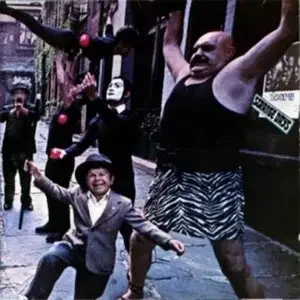Released in September 1967, Strange Days stands as the second studio album by The Doors, arriving only months after their explosive self-titled debut. At a time when the counterculture was in full bloom and psychedelic rock was rapidly evolving, The Doors carved out a distinct voice. Their sound blended poetic surrealism with blues-driven rock, and Strange Days built on this foundation with even more daring sonic and lyrical experimentation.
Rather than pivot away from the darkness and intensity of their first album, The Doors leaned in further. They expanded their sound with the introduction of new instruments like the Moog synthesizer, while lyrically, they pushed deeper into themes of alienation, disillusionment, and existential dread. The band’s frontman, Jim Morrison, continued to explore the role of the poet-shaman, blurring the line between rock star and prophetic outsider.
Sonic Exploration

Strange Days is a masterclass in mood-driven production. Engineered by Bruce Botnick and produced by Paul A. Rothchild, the album achieves a sonic clarity that feels ahead of its time. Every instrument finds its place in the mix, and the space between sounds creates a sense of eerie intimacy. This precision doesn’t sterilize the music; instead, it sharpens the surreal edges. The crispness of the recording enhances the album’s otherworldly atmosphere, allowing its darker themes to breathe and echo.
The Doors expanded their musical palette for this record, introducing more complex arrangements and textures. Ray Manzarek’s keyboards often take the lead, with the newly adopted Moog synthesizer adding a spectral layer to tracks like the title cut. Robby Krieger’s guitar work is more refined yet just as haunting, weaving jazz, flamenco, and blues influences into a cohesive whole. John Densmore’s drumming remains tightly focused, agile enough to follow the band’s sudden shifts in tone and tempo. Meanwhile, Morrison’s vocals oscillate between hypnotic murmurs and impassioned cries, lending the album a theatrical quality that draws the listener into its lyrical maze.
Musically, Strange Days continues to explore the psychedelic rock territory mapped out in the debut but does so with more nuance. It incorporates elements of acid rock, avant-garde experimentation, and even touches of baroque pop. What sets it apart is how The Doors blend these genres without losing their identity. The result is a sound that is both accessible and deeply strange, a fitting reflection of the times and a bold statement of the band’s creative ambition.
Lyrical Analysis

Lyrically, Strange Days plunges into the shadows of the human psyche. Jim Morrison draws on surrealist imagery, existential philosophy, and beat poetry to craft a world that is unsettling, introspective, and often cryptic. The album’s central themes revolve around alienation, disillusionment, and the blurred line between freedom and chaos. These ideas emerge not as overt declarations, but as fragments of dreams and visions, stitched together into lyrical puzzles.
Recurring motifs appear across the tracklist — images of streets and cities, masks and façades, lovers lost in confusion, and characters trapped in their own minds. On “People Are Strange,” Morrison sketches a portrait of urban loneliness with haunting simplicity. The title track opens the album with a carnival of confusion, setting the tone for a journey that feels both personal and prophetic. “When the Music’s Over” functions as a manifesto, channeling apocalyptic urgency and spiritual yearning into a ten-minute odyssey.
The lyrics often resist straightforward interpretation, favoring poetic abstraction over clear narrative. Yet this opacity is part of their power. Morrison’s words don’t just tell stories; they provoke questions. They hint at a deeper reality beneath the surface of daily life, one filled with wonder, dread, and infinite possibility.
Emotionally, the lyrics carry a weight that lingers. They don’t comfort — they confront. They tap into a sense of estrangement that many listeners, especially during the social turbulence of the late 1960s, could recognize. Even today, they evoke a quiet intensity, inviting listeners to look inward and consider their place in a world that often feels just as strange.
Cohesion and Flow

Strange Days unfolds with a deliberate sense of motion, its tracklist carefully structured to guide the listener through a shifting emotional and psychological landscape. The album opens with the disorienting swirl of its title track, immediately setting a tone of unease and mystery. From there, it moves through moments of sardonic detachment, sensual introspection, and existential urgency, culminating in the sprawling, cathartic “When the Music’s Over.”
Each song transitions smoothly into the next, not necessarily through musical segues but through emotional logic. The sequencing feels intuitive rather than linear, as though the album is mapping a dream rather than telling a story. “You’re Lost Little Girl” follows the bizarre charm of “Strange Days” with a softer, more melancholic touch, while “Love Me Two Times” injects a burst of sexual energy before giving way to the more meditative “Unhappy Girl.” This push and pull between intensity and restraint gives the album a hypnotic rhythm.
Thematic consistency is one of the album’s greatest strengths. Whether through lyrical content, tonal mood, or musical texture, the songs are bound by a shared sense of unease and curiosity. There are no sharp detours or half-hearted experiments. Every track, even the more upbeat ones, carries the same undercurrent of strange beauty and existential questioning. The band never loses its grip on the album’s core identity.
Standout Tracks and Moments
While Strange Days is best appreciated as a complete experience, several tracks rise to the surface for their distinctive artistry and emotional weight.
People Are Strange
“People Are Strange” is perhaps the most immediately accessible song on the album, yet it delivers one of its most profound observations. With its lilting rhythm and eerie melodic contour, it captures the alienation of the outsider with chilling precision. Morrison’s delivery is both detached and vulnerable, giving voice to a kind of psychological exile that remains deeply relatable.
Moonlight Drive
“Moonlight Drive,” one of the earliest songs written by Morrison and one of the most hauntingly poetic, stands out for its vivid nocturnal imagery and Krieger’s serpentine slide guitar. It feels like a fever dream set to music, drifting between seduction and foreboding. Another highlight is “Love Me Two Times,” which grooves with a bluesy swagger, showcasing the band’s ability to channel raw desire into something both playful and polished.
When the Music’s Over
But it is “When the Music’s Over” that stands as the album’s towering achievement. Clocking in at over ten minutes, it functions as a mini-epic, pulling together many of the album’s themes into a single, sprawling composition. The track moves through quiet meditations and explosive outbursts, with Morrison’s vocal performance shifting from whispered pleas to primal screams. The moment when he cries out, “We want the world and we want it now,” lands with seismic force — it’s a generational cry of frustration and longing, distilled into a single line.
Instrumentally, the band delivers subtle brilliance throughout. Manzarek’s use of the Moog synthesizer on the title track was pioneering, creating an unsettling texture that mirrors the song’s lyrical unease. Densmore’s jazz-influenced drumming on “My Eyes Have Seen You” adds a sense of nervous energy, while Krieger’s melodic instincts give even the most experimental passages a sense of direction.
Artistic Contribution and Innovation

Strange Days solidified The Doors’ reputation as one of the most unconventional voices in late 1960s rock. While many bands of the era leaned into the psychedelic movement with bright colors and swirling optimism, The Doors chose to explore its darker undercurrents. In doing so, they carved out a space between art rock, acid rock, and existential poetry that few others dared to occupy. The album doesn’t merely fit into its genre — it redefines the boundaries of what psychedelic rock could be.
What makes Strange Days particularly groundbreaking is its seamless blend of literary ambition and musical experimentation. At a time when rock music was gaining cultural legitimacy, The Doors proved that a band could be both commercially viable and artistically fearless. They incorporated jazz, blues, and classical elements not as embellishments, but as core components of their sound. The use of the Moog synthesizer, one of the first in a rock context, marked a bold step into electronic textures that would later become standard in progressive and experimental music.
Lyrically, Morrison’s approach was rare. He didn’t just write lyrics — he constructed metaphysical frameworks, layering personal introspection with mythic allusion. His writing invited the listener to engage intellectually as well as emotionally, something few rock frontmen of the time aspired to. That blend of depth and danger gave the band a mystique that would influence countless artists across genres, from punk to gothic rock to alternative and beyond.
Closing Thoughts

Strange Days is a rare album that manages to feel both of its time and timeless. Its strengths lie in its cohesion, its daring sonic palette, and its lyrical depth. The Doors took the blueprint they sketched with their debut and ventured further into abstraction, darkness, and beauty. The result is an album that doesn’t just entertain — it haunts, provokes, and lingers. Each track contributes to a unified artistic vision, with standout moments that showcase the band’s technical skill and philosophical ambition.
There are few weaknesses to speak of, though some listeners may find the album’s more esoteric passages challenging or its mood relentlessly somber. It isn’t designed for casual listening. Instead, it rewards attention and introspection, offering layers that reveal themselves gradually.
As a statement in The Doors’ career, Strange Days represents the band at a creative peak. It captures a group still riding the energy of early success, yet bold enough to explore deeper waters. For listeners, especially those drawn to music that pushes boundaries while retaining emotional resonance, this album remains essential.
Official Rating: 9/10
This rating reflects both the album’s historical significance and its enduring artistic value. It may not be flawless, but its ambition, execution, and impact make it one of the most compelling releases of its era — and a cornerstone of The Doors’ legacy.
